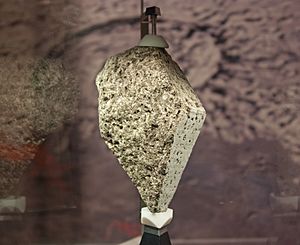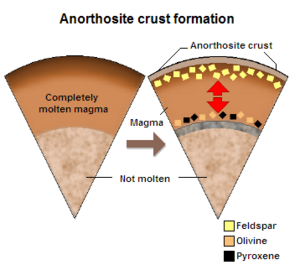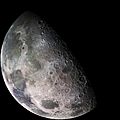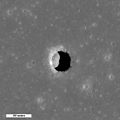Selenology facts for kids
Selenology is the science of the Moon. It is a branch of astronomy. Selenology is all about understanding our closest space neighbor. Scientists who study selenology learn about the Moon's surface, how it was formed, and what it's made of. It's like being a detective for the Moon, piecing together its long history!
Contents
Studying the Moon's Surface
When you look at the Moon, you see dark and light areas. Selenologists study these features to understand the Moon's past.
Craters and Impacts
The Moon's surface is covered in millions of craters. These are big bowls made when asteroids or comets crashed into the Moon. By studying craters, scientists can learn about how often impacts happened in the past. They can also figure out the age of different parts of the Moon. Some craters, like Copernicus, are very famous and show amazing details from these powerful impacts.
Maria and Highlands
The dark, smooth areas on the Moon are called "maria" (pronounced MAH-ree-uh). This Latin word means "seas," but they are not made of water. Instead, maria are huge plains of hardened lava from ancient volcano eruptions. The lighter, rugged areas are called "highlands." These are older, mountainous regions that are heavily cratered. Scientists study the differences between maria and highlands to understand the Moon's volcanic history and how its crust formed.
What the Moon is Made Of
Selenologists also study the rocks and minerals found on the Moon. This helps them understand its internal structure and how it evolved.
Lunar Rocks
Astronauts from the Apollo program brought back hundreds of pounds of Moon rocks. These rocks are mostly igneous rocks, formed from cooled lava. Common rocks include basalt, which is found in the maria, and anorthosite, which makes up the highlands. Studying these rocks helps scientists understand the Moon's geology. For example, anorthosite suggests that the Moon once had a global ocean of molten rock that slowly cooled.
Moon Dust
The Moon's surface is covered in a layer of fine dust called regolith. This dust is created by countless meteoroid impacts over billions of years. Selenologists study regolith to learn about the history of impacts and how the Moon's surface has changed over time.
How the Moon Formed
One of the biggest questions selenology tries to answer is how the Moon came to be.
Giant Impact Hypothesis
The most accepted idea is the giant-impact hypothesis. This theory suggests that about 4.5 billion years ago, a Mars-sized object crashed into the early Earth. This massive collision threw a huge amount of material into space. This material then clumped together to form the Moon. Selenologists use computer models and study Moon rocks to find evidence that supports this exciting theory.
Exploring the Moon
Humanity has sent many missions to the Moon, both robotic and crewed. These missions are crucial for selenology.
Robotic Missions
Robotic spacecraft, like orbiters and landers, have mapped the Moon's surface in incredible detail. They have found evidence of water ice at the Moon's poles and helped us understand its gravity and magnetic field. These missions continue to send back valuable data for selenologists to study.
Human Missions
The Apollo program in the 1960s and 1970s was a huge step for selenology. Astronauts not only walked on the Moon but also collected rock samples and set up scientific instruments. The data and samples from Apollo missions are still being studied today, giving us new insights into the Moon's secrets.
Images for kids
-
The geologic map of the Moon at 1-2.5M scale by Chinese Academy of Sciences. See the original file for higher resolution.
-
False-color image of the Moon taken by the Galileo orbiter showing geological features. NASA photo
See also
 In Spanish: Luna para niños
In Spanish: Luna para niños









